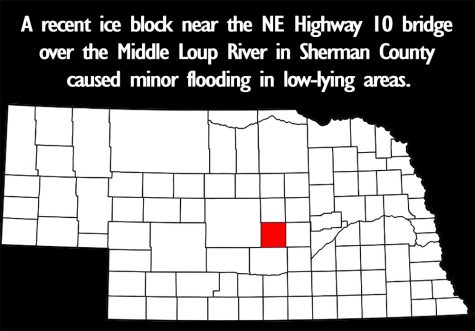Ice jams impact Sherman County residents
January 29, 2020
The National Weather Service issued a flood advisory for Sherman County on Jan. 20 caused by an ice jam near Loup City. The advisory expired on Jan. 28.
The ice jam led to minor flooding near the Nebraska Highway 10 bridge over the Middle Loup City River, just south of Loup City.
According to the Norfolk Daily News, the service says the flooding is expected to continue until the jam breaks up, which could take several days.
Dr. Jason Price, associate professor of earth science at WSC, said the ice blocks are forming by the freezing of river water. When the weather starts to warm up, the blocks move downstream with the river flow. Price said it is a common thing to occur during the spring.
“It’s just having the right conditions,” Price said. “The period of freezing, we have sufficiently cold temperatures, sufficiently long, cold temperatures below freezing to produce ice on the river and then you have a period of thawing afterwards. It’s sort of just based on meteorology and the right conditions to get the ice blocks to form.”
Ice blocks, sometimes more commonly known as “jams” or “dams,” can cause significant damage to areas depending on how acclimated the area is to them. The jams themselves can come in many different sizes depending on the freezing and thawing periods of the river water and flow.
“There are a number of things that are particularly problematic about ice dams or ice jams,” Price said. “If they get stuck, this can be on a bridge structure of some kind, something just prevents them from moving downstream, the stream narrows, whatever it is, now you start to get flooding behind it upstream. It can be more common in certain areas than others, but you can get flooding upstream which can be problematic.”
The dam structure can cause multiple problems for areas involved with major ice jams. Because the job of the dam is to control flooding downstream and control the flow of the river, and in the spring when there is a lot of water flow into the dam, then some water could possibly be let out of the dam because it could get to high. This can cause major flooding down the stream of the river.
“They may need to let water out of the dam,” Price said. “And if you add that, which is common in spring with melting, which can compound the ice damming and the ice jamming because now they are going to release more water and that could get backed up and flood and cause more flooding. It is a really difficult engineering challenge to balance.”
The ice jams are very destructive in nature, Price explained. Flooding can cause problems with erosion on the river and on farmland. The jams can also cause damage at the location of the ice dam and when it releases. In the spring when it warms up, the jam will continue to thaw, causing it to break up slightly and in a slow process. This can come with problems because there is the potential with the jam refreezing.
Once the jam does release the water downstream, either by thawing or by having engineers break the jam apart.
“That can cause flooding downstream, it can also do damage to the banks of the rivers and to structures within the river, such as bridge supports,” Price said. “The thing about rivers is the flowing water does a lot of work, which is good if you have a dam and you are producing electricity; that is a good thing. But they can also do a lot of damage, so during flooding you get a lot of erosion of the banks of the rivers. A lot of precipitation increases the discharge of the rivers. That can do a lot of erosion.”








